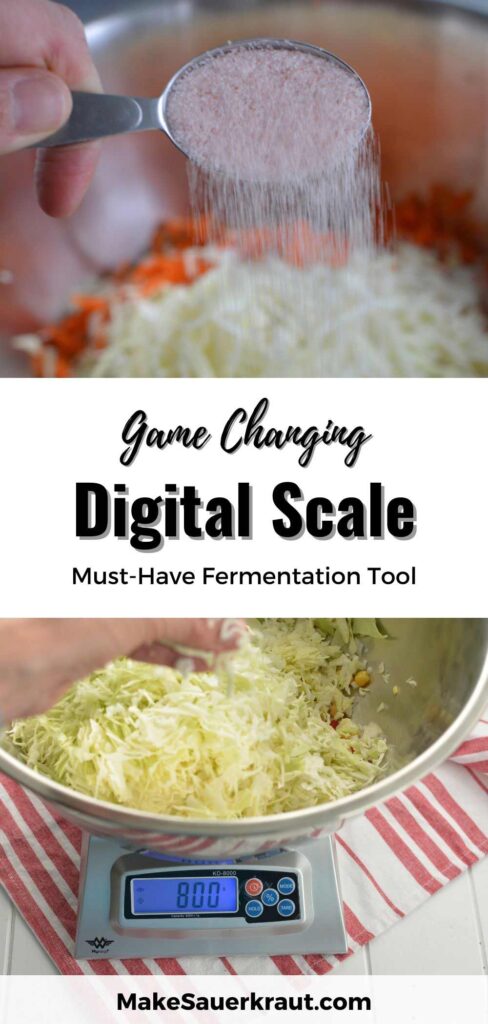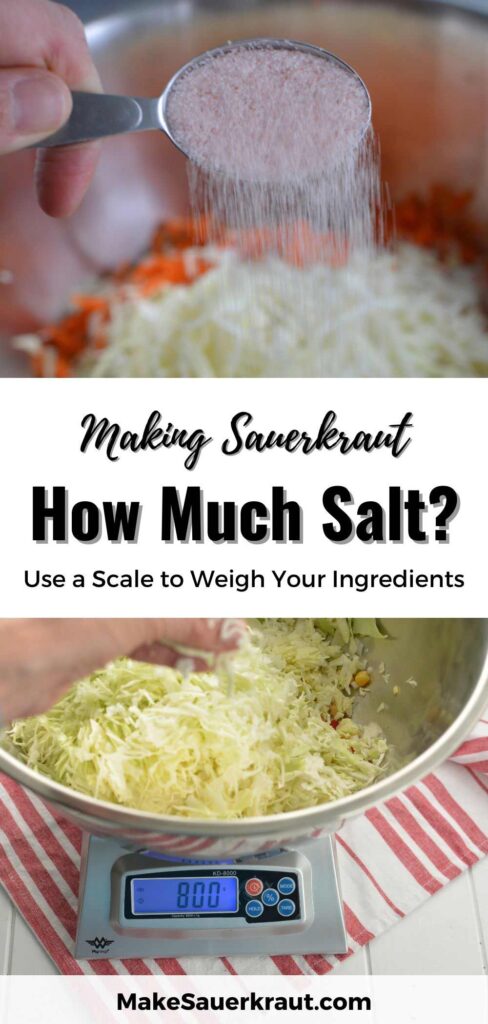Are you tired of failed fermentation attempts and unpleasant batches of pickles or sauerkraut? Look no further! Today, I’m excited to introduce you to a tool that will revolutionize your fermentation game. By simply incorporating a scale into your process, you can say goodbye to weird growths and funky smells and hello to consistently delicious and healthy ferments.
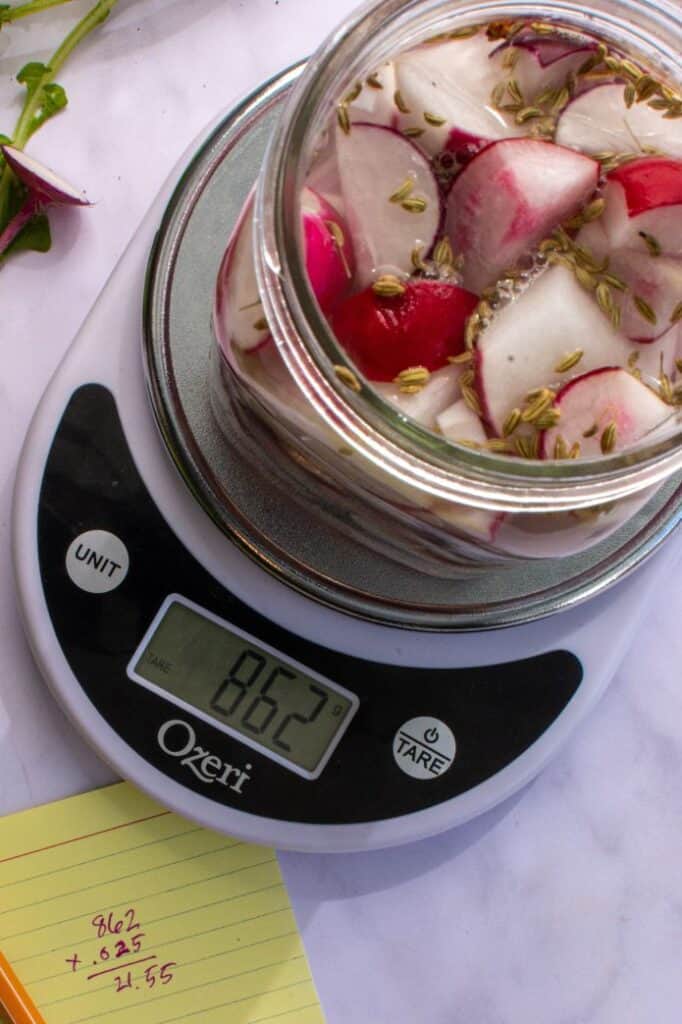
Today I’m going to share with you a must-have tool for fermentation success.
When I started using this tool for making sauerkraut, nasty-smelling batches with weird things growing on top quickly became a thing of the past.
And, when I taught dozens of workshop participants and thousands of online readers how to use this tool, their fermentation success skyrocketed.
So whether you are getting ready to make your first batch of sauerkraut or pickles or have been doing so for a while, I will explain how using a scale as part of the process can be a game-changer.
Let’s get started.
The Importance of Using the Correct Salt Concentration
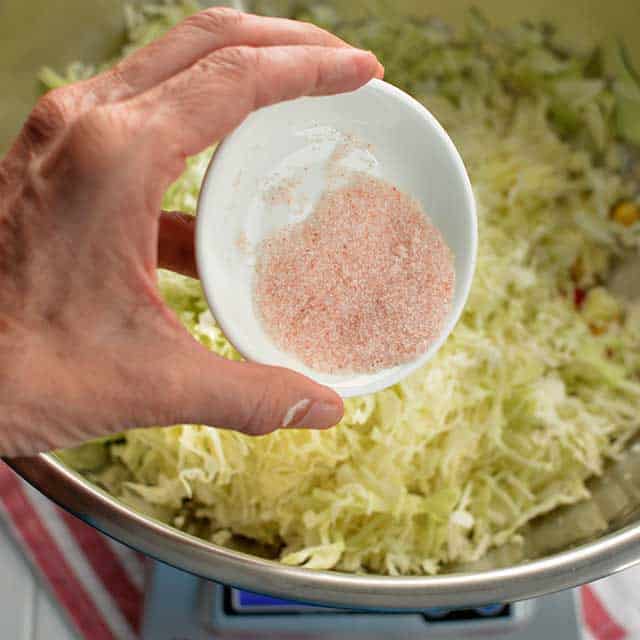
Whether you’re fermenting cucumbers into pickles, peppers into hot sauce, or cabbage into sauerkraut, you need the correct amount of salt.
The only way to accurately calculate the amount of salt to use is by using a scale to weigh your ingredients and salt.
Why?
All fruits and vegetables harbor large and diverse populations of bacteria, some good and some not so good. When we use these vegetables for fermentation, we are orchestrating a competition, a microbial race, so to speak, between the pathogenic or “bad” bacteria—along with molds and yeasts—and the beneficial or “good” bacteria on these vegetables and in the environment.
Salt is your key weapon to ensure the good guys win the race.
The CORRECT amount of salt, to be more specific.
When you mix salt into a bowl of shredded cabbage almost immediately, you’ll notice that it starts to glisten. Then, through the process of osmosis, salt extracts water from the vegetables’ cells to create a brine that the cabbage mixture is then packed in.
For pickles, you create a brine by dissolving salt in water.
In this brine, the salt-tolerant bacteria grow, thrive, and convert sugars naturally present in vegetables into lactic acid. This lactic acid then lowers the pH of your ferment to create an environment in which the salt-phobic pathogenic bacteria cannot live.
- The right amount of salt encourages the right bacteria to thrive and grow.
- Too little salt favors harmful bacteria and may cause mold or yeast to grow.
- Too much salt and the lactic acid bacteria will not multiply, and the fermentation will not properly unfold.
Using a scale to weigh your ingredients—and salt—is the best way to set up an environment in which the correct bacteria thrive and grow.
Ways to Determine How Much Salt to Use
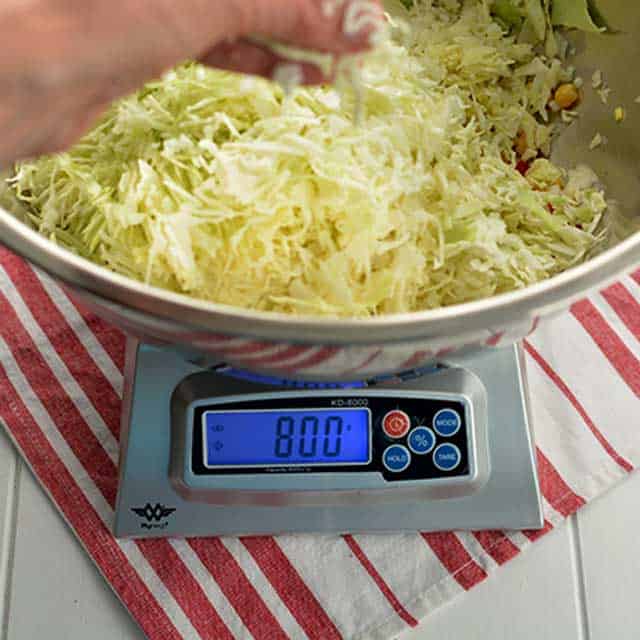
I did not start out using a scale for fermentation. However, it became an essential tool in my kitchen as I worked to perfect my process and obtain consistent, repeatable results.
Here’s the backstory for how I came to understand that fermentation is science and as a scientist, one needs to be accurate.
Where are you on this journey?
Wing It
My first batch of sauerkraut was made by slicing a head of cabbage, sprinkling in two tablespoons of salt, mixing for a bit, and then leaving it to ferment for a few weeks. Flavor, texture, and acceptance by the family were all over the map.
Some batches were too salty and didn’t taste fermented, and others were soft and musty tasting.
Looking back, this made sense because a head of cabbage can range in size and density: from that of a large grapefruit to that of a basketball. Therefore, the amount of salt in a batch can vary greatly.
By Taste
I then made sauerkraut adding salt and tasting, looking for the sensation of a “salty potato chip.” I also taught my workshop participants to do likewise. “Taste a pinch. It should taste salty but not offensively so.”
The problem is that there is a wide range of taste buds. What tastes salty to one person may not to the next.
Using this “by taste” method, I had some jars of sauerkraut with mold on the top, some jars went slimy, some turn brown and others end up tasting way too salty.
I got tired of putting in all the work to make sauerkraut, only to end up with something I didn’t want to eat. Too many jars of sauerkraut were being fed to the worms living in my compost pile.
Then, I started noticing other bloggers recommending a 2% salt concentration. I tracked down one source showing how the amount of salt used impacts the fermentation process. I was convinced and went in search of a scale.
By Weight of Ingredients
The first scale I bought was a mechanical scale—on the used circuit for $20!
Little did I know how much my fermentation life was about to change.
To make a one-quart (liter) batch, I weighed my cabbage and vegetables (1¾ pound or 800 grams) and added 1 (one) tablespoon of salt. I could calculate exactly how much salt to use to achieve the recommended 2% salt concentration.
To my delight, I soon found out I was no longer emptying jars of sauerkraut into the compost pile. Workshop participants were all achieving the same results.
The difference a simple tool can make!
By Weight of Ingredient AND Weight of Salt
Then, a reader in Australia asked me what size tablespoon I was using. That sent me down a rabbit hole, and I discovered that the volume of a tablespoon varies greatly around the world!
In Australia, a tablespoon is 20 ml; in Great Britain, 17.7 ml (at least, historically); in North America and elsewhere, 14.7 ml. That’s a 25% difference in the volume of a tablespoon between the U.S. and Australia.
In addition, as I started working with various salts, it became apparent that the same volume of one salt can weigh more or less than that of another salt. This is due to variances in grind size, density, and moisture content.
These newfound nuggets of knowledge changed my game once more.
I then started weighing my salt, using my favorite scale—don’t worry, it’s easier than you think—and a whole new world opened up for me.
For example, my fermented blueberries kept getting mold and wanted to turn to alcohol. I upped the salt concentration from 2.0% to 2.5% (16 grams to 20 grams).
The results were good, but not quite perfect. In the next batch, I increased my salt concentration to 3.0% (24 grams), which hit the sweet spot.
Now, I successfully ferment batch after batch of delicious, to-die-for fermented blueberries.
You can see why I now use a digital scale for all my fermentation projects and weigh both my ingredients and my salt.
A digital scale takes the fear and frustration out of fermentation.
I Will Never Again Make It Without Measuring

Blessings, Patty S. from Colorado
Hi, Holly ~ I just tasted your Sweet Garlic Sauerkraut after 3 weeks of fermenting. WOW! It was the best I have ever had.
I have been making sauerkraut for over two years and never bothered to weigh or measure any ingredients, but this has been an eye-opener for me. I will never again make it without measuring.
The taste, texture, and CRUNCH of this were unbelievable. I could eat the whole jar by myself. Every time I go by the fridge, I take a forkful! Thank you so much for all your work and recipes. I can’t wait to try them all!!
Purchasing a Scale
Now that I’ve convinced you—hopefully—of the necessity of a scale for fermentation, let me help you select one that fits your needs.
What to Look for When Buying a Scale
Some things to look for when selecting a scale:
- Can you read the display when a large bowl is sitting on the scale?
- Can the scale weigh at least 11 pounds (This is enough to make a bowl full of 5 pounds of sauerkraut, necessary when making larger batches or filling a large crock)?
- Are you able to set the mode to grams?
- Is there a Tare button? When you place your empty bowl on the scale and press the Tare button, it removes the weight of the bowl from the readout, enabling you to weigh just your ingredients.
- Can you program it to not automatically shut off? I know of only one scale with which you can do this. Read on.
These are the digital scales I’ve used:
Ozeri Pronto Digital Scale
The Ozeri Pronto Digital scale, and others like it, is affordable. Still, it makes a light humming noise and automatically shuts off after a minute or two, erasing any tare amount—explained below—that you were expecting to use.
The first time I used my digital scale, I put my bowl on the scale, hit the tare button to set the display to “0” grams, and then as I was slicing cabbage, it turned off. When I turned it back on, it no longer knew the weight of my bowl and I was forced to dump the contents and start the weighing process over.
Note: If you’re using a digital scale with an auto-off feature (it’s there to save battery life), write down the weight of your bowl and then add the required cabbage and vegetable weight to that number.
- Accurate, elegant, easy-to-use digital kitchen scale for your largest and smallest cooking...
- Unit Button instantly converts between 6 units of measurements (g, lbs, lbs:oz, oz, ml, kg) and...
- Precision Tare Button calculates the net weight of your ingredients by automatically...
My-Weigh KD-8000
My favorite scale—and why—is the My-Weigh KD-8000. It costs more than an entry-level digital scale, but the added quality and accuracy are worth the extra money.
Best thing? You can program it so that it does not automatically shut off!!!
A few years into using it, I learned how to use the “%” key. The My-Weigh KD-8000 is a Baker’s Math scale and is loved by breadbakers who measure flour, salt, and water by percent.
Guess what? Just like bakers, you also need to measure your vegetables, water, and salt by percent.
The “%” key on the KD-8000 scale enables you to quickly and effortlessly add a specific percent of scale to your bowl of ingredients on the scale without crunching numbers. Sweet!
Rarely a day goes by that someone in our house is not using this scale. My knitting, my son’s science experiments, and.. making sauerkraut all happen smoothly and effortlessly with my number one fermentation tool.
- PERCENTAGE: Percentage weighing function great for baking and soap making
- MODES: Large, 8000 gram capacity / 4 additional weighing modes: lbs, lbs/oz, oz and kg
- EASY CLEAN: Easy to clean stainless steel platform
See the scale section on my Fermenting Supplies page for the latest on a variety of recommended digital scale brands.
My Favorite Tools FREE Download
Say goodbye to the guesswork and hello to deliciously fermented foods with these must-have fermentation tools.
How to Use a Scale for Perfect Sauerkraut… Every Time
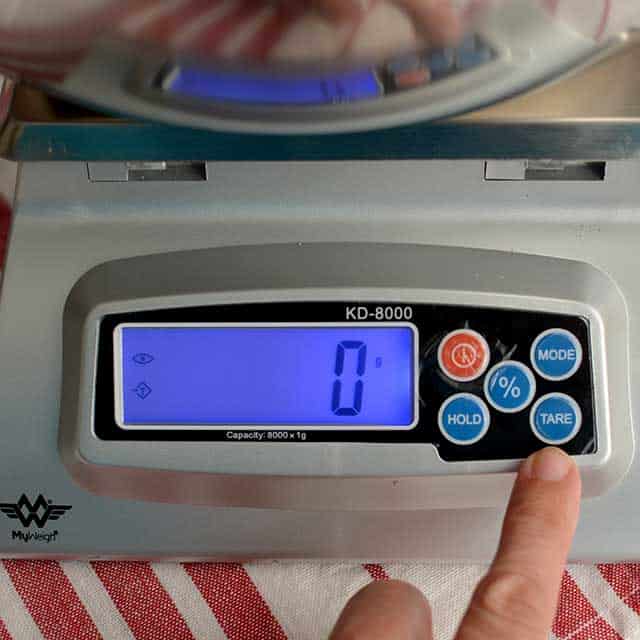
First off, understand what Tare weight means.
When making SureFire Sauerkraut, you put your bowl on the scale and add cabbage to it until you have a specified weight. We don’t want to include the bowl in our calculations, so you need to know its Tare weight. Tare is the weight of the empty bowl.
This is how you would weigh your ingredients and salt to make a one-quart (liter) batch of sauerkraut.
Here is how you would do the same for brine-fermented pickles.
1. Set up Your Scale and “Zero-Out” or Note the Tare
Turn on your scale, wait for it to power up, then switch the mode to weigh in grams. Next, place your bowl on the scale.
If you can “zero out” your scale, do so now. Most digital scales have a “tare” button for this. If not, write down the weight showing. I keep a piece of tape on the bowl I use for sauerkraut with its weight noted.
2. Add Your Vegetables and Cabbage
Prep your vegetables—grated carrots, minced garlic, and so on—and add them to the bowl on the scale. Now, add sliced cabbage to the bowl until the actual weight of your flavoring vegetables and cabbage is 800 Grams (1 3/4 pounds).
3. Add 2% Salt
For sauerkraut, we use a 2% salt concentration. For the 800 grams we have in the bowl in this example, that is 16 grams (800 x 0.02 = 16).
Add 16 grams of salt. Mix, pack, and ferment as explained in my step-by-step sauerkraut recipe.
Now you’re ready to ferment with confidence. Say goodbye to slimy, moldy sauerkraut. Set up your scale and try one of my flavorful recipes at:
Sauerkraut Recipes to Please Any Palate
If you haven’t yet purchased a scale, now’s the time to do it. The success of your sauerkraut depends upon using the correct amount of salt for the cabbage and vegetables you have sliced.
Or, if you have never made sauerkraut, follow the:
How to Make Sauerkraut in a Jar: The Complete Guide
Now, I’d like to hear from you.
How are you determining how much salt to add to your sauerkraut or ferment, and… what type of results are you getting?
Winging it?
By taste?
By weighing your ingredients?
By weighing your ingredients and weighing your salt?
Whatever method you are using, let me know by leaving a comment below.
My Favorite Tools FREE Download
Say goodbye to the guesswork and hello to deliciously fermented foods with these must-have fermentation tools.
Last update on 2024-04-25 / Affiliate links / Images from Amazon Product Advertising API

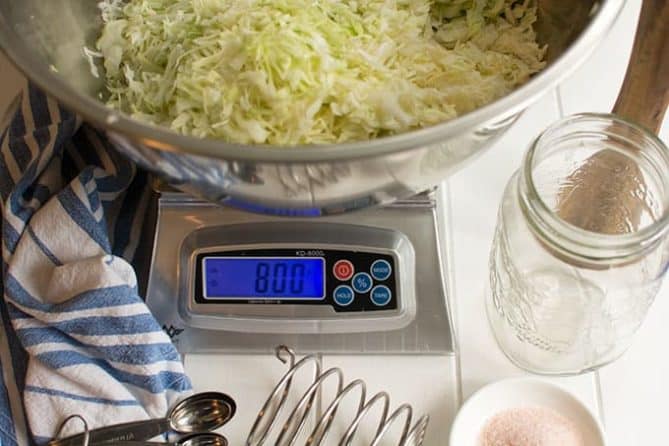

 This post may contain affiliate links which won’t change your price but will share some commission.
This post may contain affiliate links which won’t change your price but will share some commission.